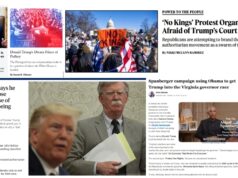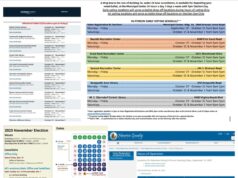The following is from former, long-time Arlington County Treasurer Frank X. O’Leary, who in his spare time analyzes early/absentee voting in order to predict election day turnout. What I find particularly interesting about O’Leary’s latest analysis is that absentee voting has spiked in Arlington, where – as O’Leary puts it – “there are no competitive local races and the Arlington vote has zero impact in those districts elsewhere in Virginia that matter.” If this is happening in Arlington, where there’s not much of anything to get voters excited this year, then how about the rest of Virginia? Also, how do O’Leary’s numbers mesh – or clash – with the statewide early/absentee voting numbers, which seem ok but certainly not off the charts? Is there something weird going on in Arlington with absentee ballots this year? What is this “discontinuity” of which O’Leary speaks, exactly? I’m not sure, but we definitely need to keep an eye on this, IMHO.
A Super Record Year?
The Absentee Vote to date in Arlington has been beyond belief – and I mean that literally. With 22 voting days remaining, 936 voters have cast their ballots. This is far beyond the prior record for absentee voting in any Constitutional Year or that of the special election in April 2014.
Comparison of Absentee Voting in Low Turnout years
2019G 2015G 2014S 2011G
22 Days to Go 936 257 235 267
Final Absentee ? 2,329 1,939 2,248
Should this pace continue, the Absentee Vote for 2019 could well exceed 8,000 with an implied Total Turnout in excess of 70,000. None of this seems likely.
Historically, we find the following for recent Constitutional Years.
|
Constitutional Year Turnout in General Elections |
|||||
|
Year |
Active Voters |
Turnout |
%Turnout |
Absentee |
%Absentee |
|
1995 |
95,190 |
39,441 |
41.4% |
1,235 |
3.1% |
|
1999 |
100,334 |
37,078 |
37.0% |
1,208 |
3.3% |
|
2003 |
102,663 |
34,141 |
33.3% |
1,064 |
3.1% |
|
2007 |
121,746 |
31,524 |
25.9% |
1,369 |
4.3% |
|
2011 |
135,594 |
35,356 |
26.1% |
2,248 |
6.4% |
|
2015 |
134,772 |
36,968 |
27.4% |
2,329 |
6.3% |
Note that as the voter rolls have grown, interest among the electorate in voting in the Constitutional Year has diminished while the tendency to vote absentee has greatly increased, particularly with the relaxation of the rules for voting absentee in 2008. This year’s dramatic increase in Absentee Voting, however, is a clear “discontinuity.” Something is going on behind the scenes that has never occurred before and, to such a degree, that my pretty little formulas seemingly will not apply to this year’s vote.
This year, the Democratic Party state-wide in seeking to maximize turnout in the hopes of taking control of both the Virginia Senate and House of Delegates – another great Blue Wave such as occurred in 2017 and 2018. This strategy does not actually apply in Arlington as there are no competitive local races and the Arlington vote has zero impact in those districts elsewhere in Virginia that matter. Even a record low or high turnout in Arlington, would have no bearing on the greater question of legislative control.
Despite this consideration, it would appear that there is deliberate effort to maximize local turnout and that effort is being reflected in an astronomic increase in the Absentee Vote. The relationship between Absentee Voting and Total Turnout, however, is correlative, and not causal, so there is no certainty that Total Turnout will be enhanced proportionally. In the absence of this effort, a Total Turnout of around 43,000 would seem likely, given the approximately 151,000 Active Voters on the rolls, but that is seemingly not the case. Given the limited but obvious evidence of an effective turnout campaign, Absentee Turnout may exceed 8,000. Should it do so, I believe that a Total Turnout exceeding 60,000 (as some have posited) is conceivable but doubtful.
I plan to revisit this subject in a few weeks as the Absentee Vote further develops. Meanwhile, I wish you all a Many Happy Returns.
FXO












![Saturday News: “Trump’s latest tariff TACO probably won’t make your life more affordable”; “The Epstein Email Cache: 2,300 Messages, Many of Which Mention Trump”; “[MTG] questions if Trump is still the ‘America First’ president”; “Jim Ryan tells all: ‘What did the Governor know, when did he know it?’”](https://bluevirginia.us/wp-content/uploads/2025/11/montage1115-100x75.jpg)
